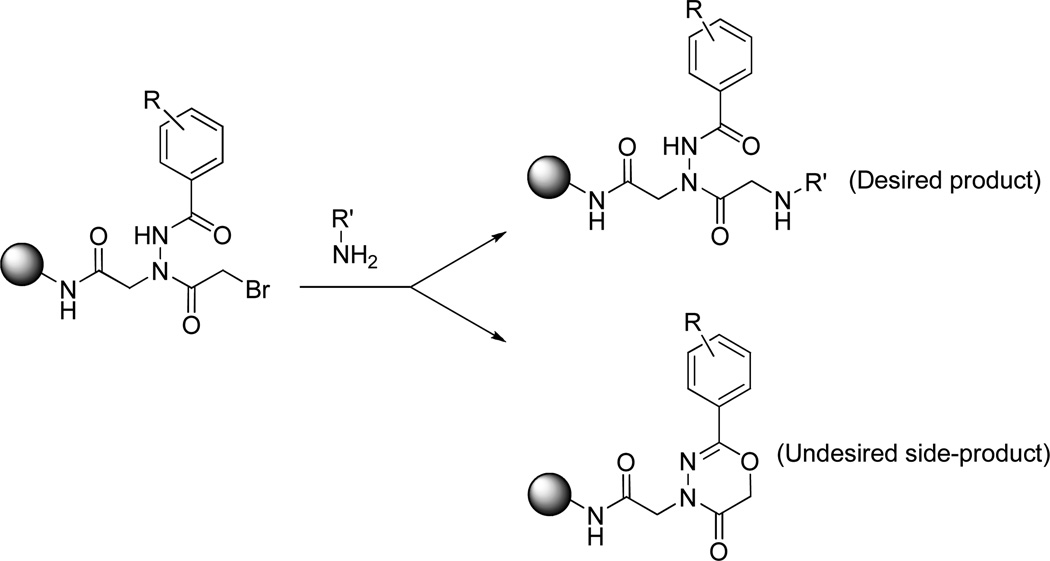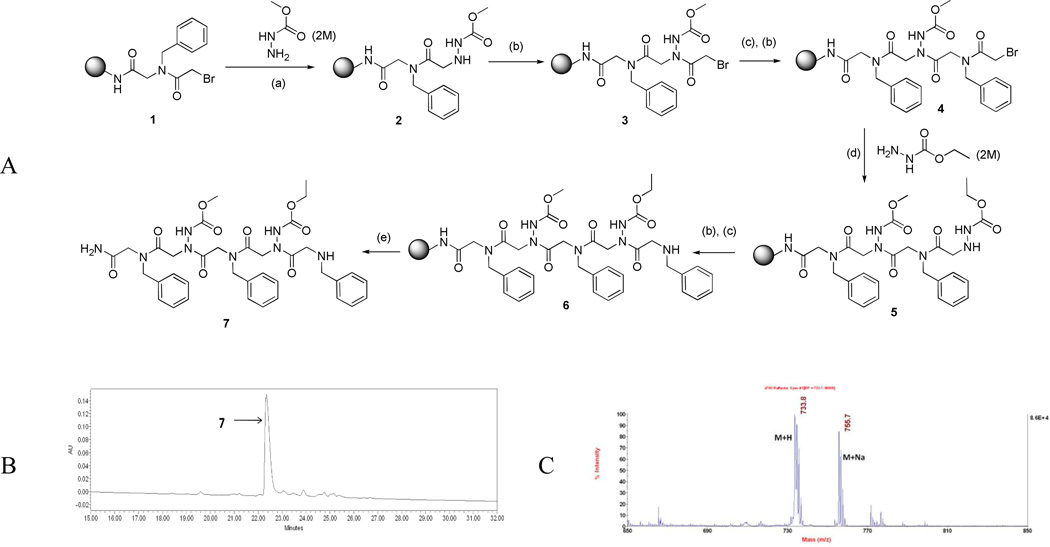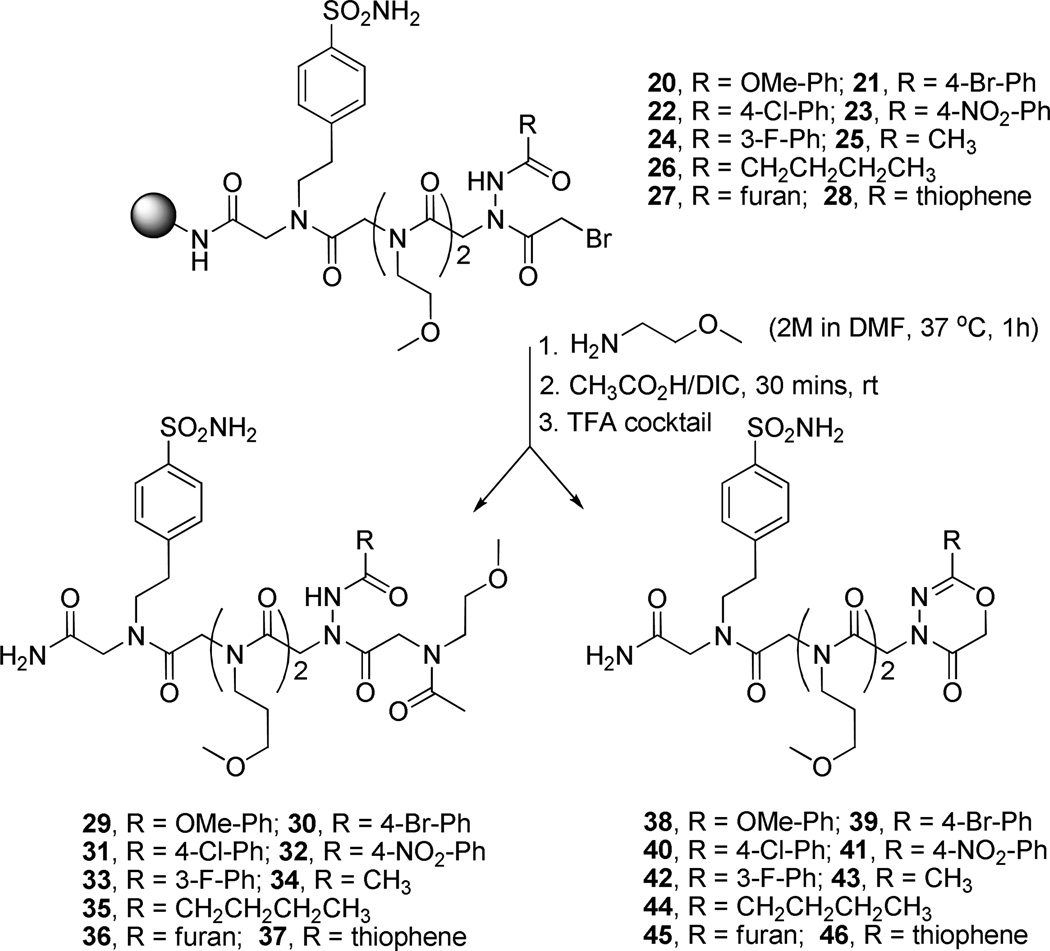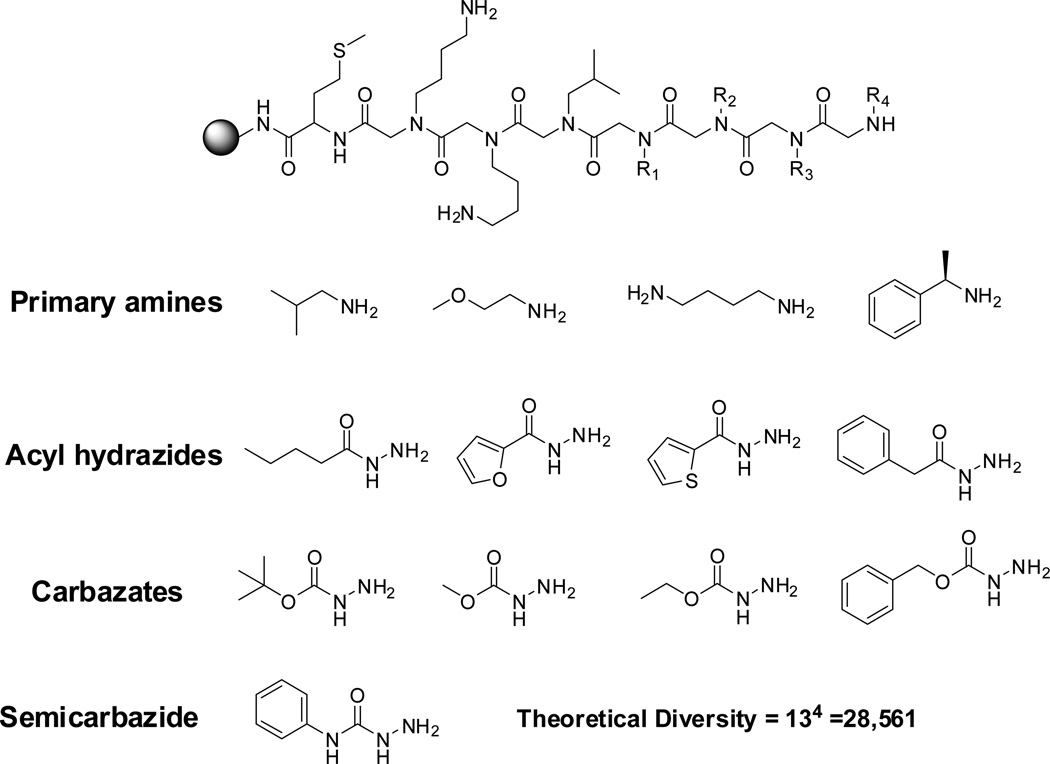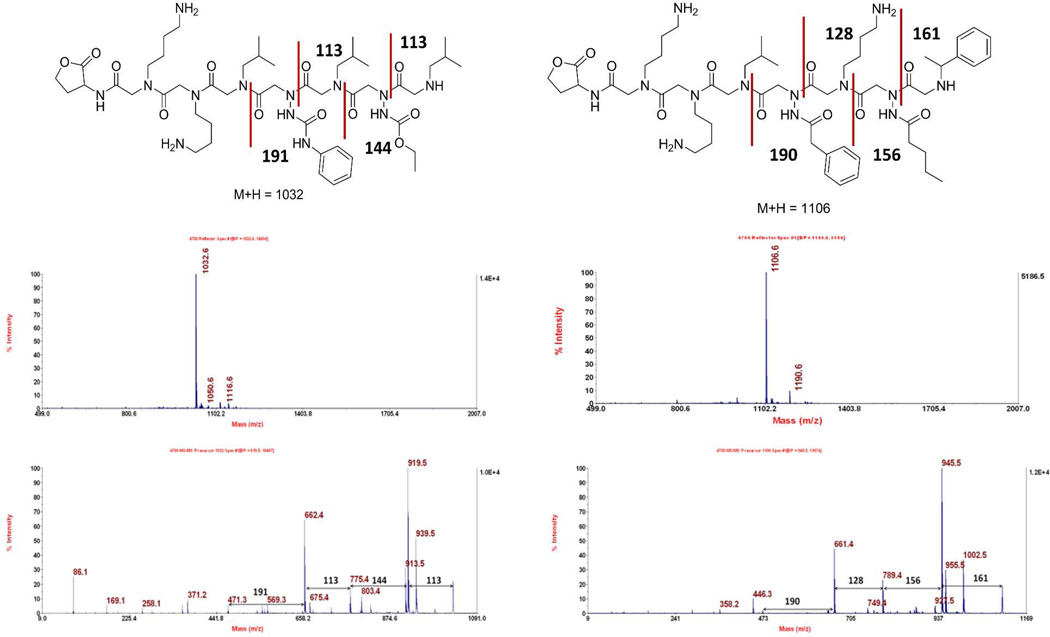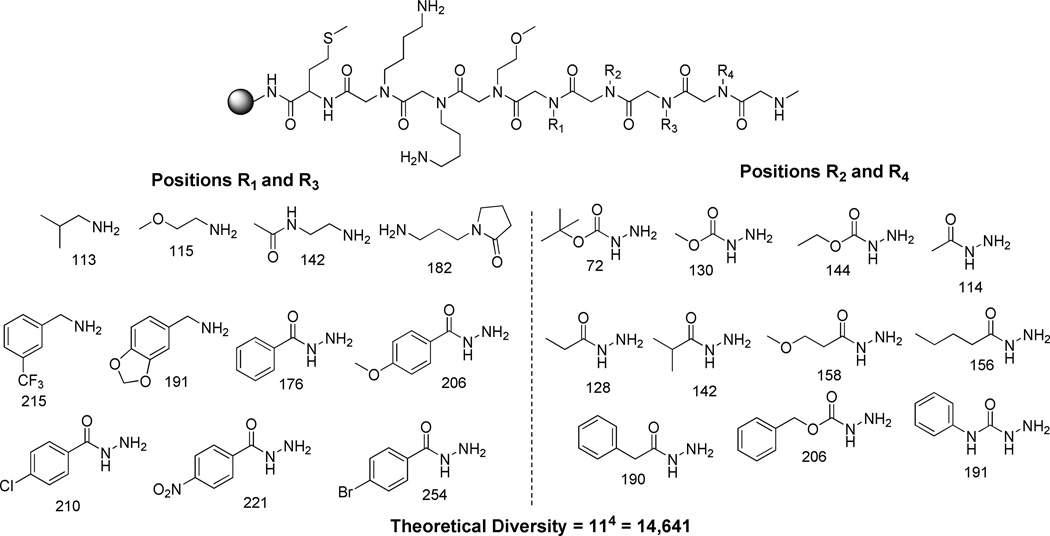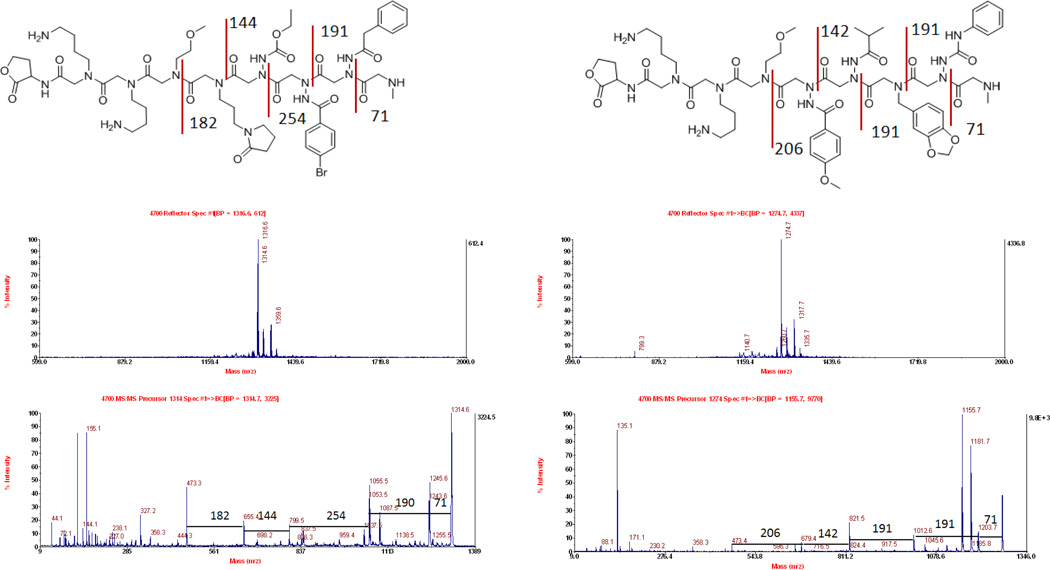Abstract
We recently reported efficient conditions for the synthesis of N-azapeptoid libraries via the typical sub-monomer strategy of peptoid synthesis, but that substitutes N-acyl hydrazides for primary amines as sub-monomers. Unfortunately, this approach is not applicable to the synthesis of mixed azapeptoid-peptoid libraries. When an oligomer containing an N-terminal side chain derived from an acyl hydrazide is bromoacetylated and treated with a primary amine, a chain-terminating intramolecular ring-closure to form an oxadiazinone competes with the desired displacement of the bromide by the amine. Here we overcome this limitation and demonstrate that a hybrid peptoid-azapeptoid library derived from primary amines, acyl hydrazides, carbazates and semicarbazides can be made efficiently using standard peptoid submonomer chemistry. We find that the unwanted, chain-terminating cyclization reaction is competitive with chain extension only when aryl acyl hydrazides are present. Alkyl or heteroaromatic acyl hydrazides do not cyclize under the conditions used for peptoid-azapeptoid synthesis. We also find that carbazates and semi-carbazides work well for chain extension. Using primary amines, acyl hydrazides, carbazates and semicarbazides as sub-monomers, a high-quality one bead one compound library of tetramers suitable for screening against protein targets was made by split and pool synthesis.
There is great interest in the development of peptidomimetic compounds as ligands for proteins and RNAs. Of the many classes of peptide-like compounds, peptoids1 (oligo-N-alkyl-glycines) are exceptional with respect to their ease of construction. The “sub-monomer” solid-phase synthesis of peptoids involves two steps.2 A resin-bound amine is first acylated with an activated form of 2- bromoacetic acid, followed by displacement of bromide by a primary amine. Because of the ready availability of thousands of different primary amines, huge, diverse combinatorial libraries of libraries can be created by split and pool synthesis3. When library synthesis is carried out on hydrophilic TentaGel beads, the library can be screened directly against protein targets of interest and the identity of “hits” can be easily deduced by mass spectrometry following cleavage of the compound from the bead.4 An additional advantage of peptoids is that they are serum stable5 and generally cell permeable6. Thus, peptoid libraries are a powerful tool for the discovery of useful tool compounds or drug leads.
Unfortunately, the utility of peptoids is limited by their lack of conformational constraints, or “floppiness”, which is thought to limit their affinity for macromolecular targets. Very few peptoids with a nanomolar affinity for their protein target have been reported.7 Unlike peptides, the tertiary amide bond in peptoids does not exhibit a strong preference for the trans geometry, nor are there significant constraints to rotation about the carbonyl-Cα or the Cα-N bonds in the backbone. Hence, strategies to introduce structural constraints into peptoid-like oligomers, without sacrificing the many advantages of sub-monomer synthesis, have attracted significant interest8–11. Our group has also turned its attention to this issue, with a companion goal of introducing greater chemodiversity into the molecules. Recently, we reported that aryl-substituted acyl hydrazides can be used efficiently as sub-monomers to generate N-azapeptoid oligomers.12 These compounds (Figure 1) are structurally distinct from azapeptoids,13 hydrazino azapeptoids14 and retro hydrazino azapeptoids15 reported previously. The presence of hydrogen bond donor and acceptor units in the side chain of acyl hydrazides may prove useful in engaging protein targets. Moreover, unlike peptoids, the 1H NMR spectra of these compounds are dominated by one isomer (>90%) and, based on the X-ray crystal structure of one such compound, we suggested that the amide bonds of these azapeptoids exist almost exclusively in the trans conformation.12
Figure 1.
In addition to the desired chain extension (top reaction), a chain-terminating ring closure reaction occurs when N-bromoacylated azapeptoids are treated with primary amines.
Ideally, we would like to employ acyl hydrazides along with more traditional amine submonomers in the synthesis of mixed peptoid-azapeptoid libraries. However, our attempts to imbed N-azaacyl units into a chain of standard peptoids were unsuccessful due to a competing side reaction involving ring closure to form 2-aryl-4H-1,3,4-oxadiazin-5(6H)-ones (Figure 1).12 The identities of the side products were confirmed by NMR and mass spectrometric studies.12 In this reaction, the amine acts as a base to deprotonate the side chain N-H, aiding in the cyclization of the carbonyl oxygen onto the methylene group of the 2-bromoacetyl unit. The cyclization reaction does not occur when an acylhydrazide is employed as the sub-monomer, presumably due to its reduced basicity relative to a primary amine. Thus, while the synthesis of libraries using solely N-acylhydrazides as sub-monomers works well, this cyclization frustrates attempts to make mixed high quality libraries of mixed azapeptoid-peptoid chains.
Herein, we report a solution to this problem that allows N-azapeptoid units to be imbedded into a standard peptoid chain. We further show that related molecules such as carbazates and semicarbazides, which also contain similar hydrogen donor-acceptor moieties in their side chains, can be used as sub-monomers along with amines. Given that many amines, carbazates, semicarbazides and acyl hydrazides are commercially available and hundreds more can be made easily, this chemistry allows access to new types of large combinatorial libraries of diverse peptoid oligomers.
Results and Discussion
New hydrazide sub-monomers
We first decided to explore if carbazates (Figure 2A), which differ from acyl hydrazides by the presence of an oxygen atom attached to the acyl group rather than a phenyl ring, might avoid the undesired cyclization reaction. We used methyl and ethyl carbazates to synthesize peptoid-azapeptoid hybrid 7. For that purpose we synthesized compound 1 by using standard microwave assisted synthesis conditions (see supplementary material) and subsequently incorporated methyl and ethyl carbazates to synthesize compound 7. Gratifyingly, when methyl and ethyl carbazates were inserted between benzyl amines to synthesize a peptoid-azapeptoid hybrid (7) (see Figure 2A), the desired peptoid-azapeptoid product was obtained in high purity, with no observable ring closure product, as determined by HPLC (see Figure 2B) and MALDI-TOF mass spectrometry (see Figure 2C).
Figure 2.
(A) Synthesis of peptoid-azapeptoid hybrid 7. (a) 37 °C, 1h; (b) BrCH2COOH (2 M in DMF), DIC (2 M in DMF), 37 °C, 10 mins; (c) Benzyl amine (2 M in DMF), 37 °C, 1h; (d) 37 °C,1h ; (e) TFA cocktail, 1h, rt. (B) HPLC spectrum of crude reaction mixture obtained after TFA cleavage of 6. (C) MALDI TOF MS spectra of HPLC purified 7.
This favorable result led us to explore more fully how the nature of the unit attached to the carbonyl group in the side chain influences the ratio of desired chain extension and undesired ring closure. Therefore, compounds 8–11 (Figure 3) were synthesized and subjected to chain extension using isopropylamine as the sub-monomer. As anticipated from our previous work,12 when R=Ph the ring closure reaction was relatively efficient and a mixture of ring-closed and chain-extended products was observed (Figure 3). However, when R = CH2Ph the ring closure product 17 was not observed and the desired chain-extended species 13 was produced in high yield and purity. Similarly, when benzyl carbazate and 4-phenyl semicarbazide were used, followed by isopropyl amine, the ring-closed species 18 and 19 were not observed by MALDI TOF MS and HPLC analysis of the crude reaction mixtures. Only the chain-extended products 14 (R = OCH2Ph) and 15 (R= NHPh) were produced.
Figure 3.
(a) Reaction of 8–11 with isopropyl amine. (b) HPLC chromatogram of crude reaction mixtures obtained from reaction of 8–11 with isopropyl amine.
Aryl acyl hydrazides cannot be chain extended cleanly
These results suggest that the ring closure reaction competes with the desired SN2 bromide displacement by amine only when R is a phenyl ring directly attached to the acyl group. To probe this further, we used several substitued phenyl hydrazides and 2-methoxyethylamine, which lacks a branched center adjacent to nitrogen and thus should be a better nucleophile, to synthesize compounds 20–28 (Figure 4).16 We observed that the amount of ring-closed side product increases with an increase in the electron-withdrawing ability of the substituent in the phenyl ring. The electron-withdrawing group increases the acidity of the NH hydrogen of the side chain due to which the incoming amine base can easily abstract the NH hydrogen and assist the carbonyl oxygen to undergo intramolecular cyclization. We also explored the use of aliphatic and heterocyclic-substituted acyl hydrazides in the synthesis of mixed oligomers (Figure 4). For compounds 27 and 28, where R = furan and thiophene, respectively, only small amounts of ring closure products (~10% for 2-thiophene hydrazide and ~5% for 2-furoic hydrazide) were detected by HPLC and MALDI-TOF MS (see Supporting Information). When R = an alkyl group, only chain elongation products 34 and 35 were observed and the corresponding ring closure products (43 and 44) were not observed by MALDI-TOF MS and HPLC. These findings are summarized in Table 1. We conclude that acyl hydrazides, carbazates and semicarbazides can be employed as sub-monomers for the synthesis of mixed azapeptoid-peptoid oligomers so long as R is not a phenyl ring.
Figure 4.
Reaction of 20–28 with 2-methoxyethylamine.
Table 1.
Cyclic six-membered ring formation (%) with respect to the expected chain elongation product.
| R | Amine | Cyclic product (%) |
|---|---|---|
| Ph | Isopropyl amine | 63 |
| CH2Ph | Isopropyl amine | ND |
| OCH2Ph | Isopropyl amine | ND |
| NHPh | Isopropyl amine | ND |
| 4-OMe-Ph | 2-methoxyethyl amine | 4 |
| 4-Br-Ph | 2-methoxyethyl amine | 15 |
| 4-Cl-Ph | 2-methoxyethyl amine | 16 |
| 4-NO2-Ph | 2-methoxyethyl amine | 45 |
| 3-F-Ph | 2-methoxyethyl amine | 15 |
| Thiophene | 2-methoxyethyl amine | 10 |
| Furan | 2-methoxyethyl amine | 6 |
| CH2CH2CH2CH3 | 2-methoxyethyl amine | ND |
| CH3 | 2-methoxyethyl amine | ND |
ND-not detected based on MALDI MS and HPLC of crude reaction mixture
Library synthesis
As it is not realistic to synthesize individual compounds to test the compatibility of different R groups in acyl hydrazides with every other primary amine, we decided to construct an OBOC library to screen the R groups that provide the expected chain elongation products without undergoing the undesired ring termination reaction. This is determined by looking at the MALDI MS spectra of the individual peptoid-azapeptoid obtained after CNBr treatment. For that purpose, we used solid-phase split and pool synthesis to create an OBOC hybrid peptoidazapeptoid library of tetramers on 160 µm TentaGel Macrobeads NH2 resin using amines, acyl hydrazides (R ≠ aryl), carbazates and semicarbazides (see Figure 5) with a theoretical diversity of 28,561 compounds. Several individual beads were picked at random, separated into the wells of a microtiter plate, and the compounds were released into solution by reacting individual beads with a 0.3 M CNBr solution, which results in cleavage of a methionine present in the invariant linker. MALDI TOF/TOF MS analysis showed strong molecular ions, which indicates the high quality of the library. The MALDI TOF MS and MSMS of two single beads are shown in the Figure 6 and remaining MALDI TOF MS and MSMS spectra are shown in the Supplementary Information. Only in cases of when primary amines are used after 2-thiophene carboxylic acid hydrazide and 2-furoic acid hydrazide, we observed minor peaks corresponding to the ring closed products, which is consistent with our earlier observation (Figure 4, compound 27 and 28 and Table 1). Therefore, we eliminated 2-thiophene carboxylic acid hydrazide and 2-furoic acid hydrazide from our subsequent studies. Importantly, like peptoids, the molecular ions when fragmented, provided unequivocal sequence data (see Supporting Information).4 We conclude that this is a high quality library suitable for screening against various macromolecular targets.17
Figure 5.
Primary amine, acyl hydrazide, carbazate and semicarbazide sub-monomers used in the tetramer hybrid peptoid-azapeptoid library.
Figure 6.
Representative MALDI TOF MS and MSMS spectra of two compounds of the tetramer peptoid-azapeptoid hybrid library obtained after single bead cleavage by using CNBr.
Mixing amine and aryl acyl hydrazides at the same position in the library
To achieve maximum diversity in a library synthesis, it would be desirable to employ both standard amine and acyl hydrazide sub-monomers of all types at any position in the oligomer. However, this will cause problems in the addition of the next unit of the oligomer when the preceding residue has an aryl acyl hydrazide side chain (Figure 1). Presumably, one way to abrogate this problem is to employ at the position following an aryl acyl hydrazide only sub-monomers that cannot trigger the chain-terminating cyclization reaction and, in addition, are tolerant of the use in any sub-monomer at the next residue.
To demonstrate this point, we used solid-phase split and pool synthesis to create an OBOC hybrid peptoid-azapeptoid library of tetramers on 75 µm TentaGel resin by using primary amines and aryl acyl hydrazides in positions 1 and 3 (position 1 is the most C-terminal variable residue), but restricted the sub-monomers used at positions 2 and 4 to alkyl or benzyl acyl hydrazides, carbazates and semicarbazides (see Figure 7). Finally, we incorporated methylamine at the N-terminus.18 The theoretical diversity of the library was 14,641 compounds. Several individual beads were picked at random, separated into the wells of a microtiter plate, and the compounds were released into solution by reacting individual beads with a 0.3 M CNBr solution, which results in cleavage of a methionine present in the invariant linker. MALDI TOF/TOF MS analysis showed strong molecular ions, which indicates the high quality of the library. The MALDI TOF MS and MSMS spectra of two such single beads are shown in Figure 8.
Figure 7.
Peptoid-azapeptoid library synthesized by using primary amines and aryl acyl hydrazides at positions 1 and 3. Alkyl or benzyl acyl hydrazides, carbazates and semicarbazides are used at positions 2 and 4 as spacers between aryl acyl hydrazides and amines.
Figure 8.
Representative MALDI TOF MS and MSMS spectra of two compounds obtained after single bead cleavage by using CNBr from the tetramer peptoid-azapeptoid hybrid library described in Figure 7.
Summary
We have shown that peptoid-azapeptoid hybrid libraries derived from amines, acyl hydrazides, carbazates and semicarbazides can be made conveniently and efficiently using standard peptoid sub-monomer chemistry and that the structure of a compound displayed on a single bead can be determined by tandem mass spectrometry. Further, we show that acyl hydrazides, carbazates and semicarbazides monomers can be used as spacers between aryl acyl hydrazides and amines to synthesize peptoid-azapeptoid hybrid library without losing any diversity. Given that many carbazates, semicarbazides and hydrazides are commercially available and hundreds more can be made easily from carboxylic acids, these building blocks, together with amines, represent a rich source of sub-monomers for the synthesis of interesting oligomeric libraries.
Supplementary Material
Acknowledgements
This work was supported by a contract from the National Heart Lung and Blood Institute (NHLBI Proteomics Center, NO1-HV-00242).
Footnotes
† Electronic Supplementary Information (ESI) available: [Experimental details, HPLC traces, MALDI TOF MS and MSMS spectra of different compounds.]. See DOI:
Notes and references
- 1.Simon RJ, Kania RS, Zuckermann RN, Huebner VD, Jewell DA, Banville S, Ng S, Wang L, Rosenberg S, Marlowe CK, Spellmeyer DC, Tan R, Frankel AD, Santi DV, Cohen FE, Bartlett PA. Peptoids: a modular approach to drug discovery. Proc. Natl. Acad. Sci. U.S. A. 1992;89(20):9367–9371. doi: 10.1073/pnas.89.20.9367. [DOI] [PMC free article] [PubMed] [Google Scholar]
- 2.Zuckermann RN, Kerr JM, Kent SBH, Moos WH. Efficient method for the preparation of peptoids [oligo(N-substituted glycines)] by submonomer solid-phase synthesis. J. Am. Chem. Soc. 1992;114(26):10646–106467. [Google Scholar]
- 3.(a) Lam KS, Salmon SE, Hersh EM, Hruby VJ, Kazmierski WM, Knapp RJ. A new type of synthetic peptide library for identifying ligand-binding activity. Nature. 1991;354:82–84. doi: 10.1038/354082a0. [DOI] [PubMed] [Google Scholar]; (b) Houghten RA, Pinilla C, Blondelle SE, Appel JR, Dooley CT, Cuervo JH. Generation and use of synthetic peptide combinatorial libraries for basic research and drug discovery. Nature. 1991;354:84–86. doi: 10.1038/354084a0. [DOI] [PubMed] [Google Scholar]; (c) Furka A, Sebestyen F, Asgedom M, Dibo G. General Method for rapid synthesis of multicomponent peptide mixtures. Int. J. Pept. Protein Res. 1991;37(6):487–493. doi: 10.1111/j.1399-3011.1991.tb00765.x. [DOI] [PubMed] [Google Scholar]; (d) Lam KS, Krchnak V, Lebl M. The “One-Bead-One-Compound” Combinatorial Library Method. Chem. Rev. 1997;97(2):411–448. doi: 10.1021/cr9600114. [DOI] [PubMed] [Google Scholar]
- 4.(a) Heerma W, Versluis C, de Koster CG, Kruijtzer JAW, Zigrovic I, Liskamp RMJ. Comparing Mass Spectrometric Characteristics of Peptides and Peptoids. Rapid Commun. Mass Spectrom. 1996;10(4):459–464. doi: 10.1002/(SICI)1097-0231(19960315)10:4<459::AID-RCM501>3.0.CO;2-J. [DOI] [PubMed] [Google Scholar]; (b) Heerma W, Boon JPJL, Versluis C, Kruijtzer JAW, Hofmeyer LJF, Liskamp RMJ. Comparing Mass Spectrometric Characteristics of Peptides and Peptoids—2. J. Mass Spectrom. 1997;32(7):697–704. doi: 10.1002/(SICI)1097-0231(19960315)10:4<459::AID-RCM501>3.0.CO;2-J. [DOI] [PubMed] [Google Scholar]; (c) Ruijtenbeek R, Versluis C, Heck AJR, Redegeld FAM, Nijkamp FP, Liskamp RMJ. Characterization of a phosphorylated peptide and peptoid and peptoid–peptide hybrids by mass spectrometry. J. Mass Spectrom. 2002;37(1):47–55. doi: 10.1002/jms.245. [DOI] [PubMed] [Google Scholar]
- 5.Miller SM, Simon RJ, Ng S, Zuckermann RN, Kerr JM, Moos WH. Proteolytic studies of homologous peptide and N-substituted glycine peptoid oligomers. Bioorg. Med. Chem. Lett. 1994;4(22):2657–2662. [Google Scholar]
- 6.(a) Yu P, Liu B, Kodadek T. A high-throughput assay for assessing the cell permeability of combinatorial libraries. Nat. Biotechnol. 2005;23(6):746–751. doi: 10.1038/nbt1099. [DOI] [PubMed] [Google Scholar]; (b) Kwon Y-U, Kodadek T. Quantitative Evaluation of the Relative Cell Permeability of Peptoids and Peptides. J. Am. Chem. Soc. 2007;129(6):1508–1509. doi: 10.1021/ja0668623. [DOI] [PMC free article] [PubMed] [Google Scholar]
- 7.Zuckermann RN, Martin EJ, Spellmeyer DC, Stauber GB, Shoemaker KR, Ken JM, Figliozzi GM, Goff DA, Siani MA, Simon RJ, Banville SC, Brown EG, Wang L, Richter LS, Moos WH. Discovery of Nanomolar Ligands for 7-Transmembrane, G-Protein-Coupled Receptors from a Diverse N-(Substituted)glycine Peptoid Library. J. Med. Chem. 1994;37(17):2678–2685. doi: 10.1021/jm00043a007. [DOI] [PubMed] [Google Scholar]
- 8.(a) Kirshenbaum K, Barron AE, Goldsmith RA, Armand P, Bradley EK, Truong KTV, Dill KA, Cohen FE, Zuckermann RN. Sequence-specific polypeptoids: A diverse family of heteropolymers with stable secondary structure. Proc. Natl. Acad. Sci. U.S.A. 1998;95(8):4303–4308. doi: 10.1073/pnas.95.8.4303. [DOI] [PMC free article] [PubMed] [Google Scholar]; (b) Armand P, Kirshenbaum K, Goldsmith RA, Farr-Jones S, Barron AE, Truong KTV, Dill KA, Mierke DF, Cohen FE, Zuckermann RN, Bradley EK. NMR determination of the major solution conformation of a peptoid pentamer with chiral side chains. Proc. Natl. Acad. Sci. U. S. A. 1998;95(8):4309–4314. doi: 10.1073/pnas.95.8.4309. [DOI] [PMC free article] [PubMed] [Google Scholar]; (c) Wu CW, Kirshenbaum K, Sanborn TJ, Patch JA, Huang K, Dill KA, Zuckermann RN, Barron AE. Structural and Spectroscopic Studies of Peptoid Oligomers with, α-Chiral Aliphatic Side Chains. J. Am. Chem. Soc. 2003;125(44):13525–13530. doi: 10.1021/ja037540r. [DOI] [PubMed] [Google Scholar]; (d) Shah NH, Butterfoss GL, Nguyen K, Yoo B, Bonneau R, Rabenstein DL, Kirshenbaum K. Oligo(N-glycines): A New Twist on Structured Peptoids. J. Am. Chem. Soc. 2008;130(49):16622–16632. doi: 10.1021/ja804580n. [DOI] [PubMed] [Google Scholar]; (e) Lee JH, Zhang Q, Jo S, Chai SC, Oh M, Im W, Lu H, Lim HS. Novel Pyrrolopyrimidine-Based, α-Helix Mimetics: Cell-Permeable Inhibitors of Protein−Protein Interactions. J. Am. Chem. Soc. 2011;133(4):676–679. doi: 10.1021/ja108230s. [DOI] [PMC free article] [PubMed] [Google Scholar]
- 9.Huang K, Wu CW, Sanborn TJ, Patch JA, Kirshenbaum K, Zuckermann RN, Barron AE, Radhakrishnan I. A Threaded Loop Conformation Adopted by a Family of Peptoid Nonamers. J. Am. Chem. Soc. 2006;128(5):1733–1738. doi: 10.1021/ja0574318. [DOI] [PMC free article] [PubMed] [Google Scholar]
- 10.Pokorski JK, Miller Jenkins LM, Feng H, Durell SR, Bai Y, Appella DH. Introduction of a Triazole Amino Acid into a Peptoid Oligomer Induces Turn Formation in Aqueous Solution. Org. Lett. 2007;9(12):2381–2383. doi: 10.1021/ol070817y. [DOI] [PubMed] [Google Scholar]; (b) Shin SBY, Kirshenbaum K. Conformational Rearrangements by Water-Soluble Peptoid Foldamers. Org. Lett. 2007;9(24):5003–5006. doi: 10.1021/ol702207n. [DOI] [PubMed] [Google Scholar]
- 11.Stringer JR, Crapster JA, Guzei IA, Blackwell HE. Construction of Peptoids with All Trans-Amide Backbones and Peptoid Reverse Turns via the Tactical Incorporation of N-Aryl Side Chains Capable of Hydrogen Bonding. J. Org. Chem. 2010;75(18):6068–6078. doi: 10.1021/jo101075a. [DOI] [PMC free article] [PubMed] [Google Scholar]
- 12.Sarma BK, Yousufuddin M, Kodadek T. Acyl hydrazides as peptoid sub-monomers. Chem. Commun. 2011;47:1059–10592. doi: 10.1039/c1cc12750k. [DOI] [PMC free article] [PubMed] [Google Scholar]
- 13.Gibson C, Goodman SL, Hahn D, Holzemann G, Kessler H. Novel solid-phase synthesis of azapeptides and azapeptoids via Fmoc-strategy and its applications in the synthesis of RGD-mimetics. J. Org. Chem. 1999;64:7388–7394. [Google Scholar]
- 14.Cheguillaume A, Lehardy F, Bouget K, Baudy-Floc’h M, Grel PL. Submonomer Solution Synthesis of Hydrazinoazapeptoids, a New Class of Pseudopeptides. J. Org. Chem. 1999;64(8):2924–2927. doi: 10.1021/jo981487l. [DOI] [PubMed] [Google Scholar]
- 15.Aubin S, Martin B, Delcros J, Arlot-Bonnemains Y, Baudy-Floc’h M. Retro Hydrazino-azapeptoids as Peptidomimetics of Proteasome Inhibitors. J. Med. Chem. 2005;48(1):330–334. doi: 10.1021/jm049455f. [DOI] [PubMed] [Google Scholar]
- 16.In compounds 20–28, we used 4-(2-aminoethyl)benenesulfonamide as a sub-monomer to increase the mass of the constant region so that the mass of the products formed (29–46) are far away from the matrix dominated mass region in the MALDI TOF MS. Moreover, we observed that peptoids having a 4-(2-aminoethyl)benenesulfonamide residue usually have strong molecular ion intensities [M+H] in the MALDI TOF MS.
- 17.(a) Alluri PG, Reddy MM, Bacchawat-Sikder K, Olivos HJ, Kodadek T. Isolation of Protein Ligands from Large Peptoid Libraries. J. Am. Chem. Soc. 2003;125(46):13995–14004. doi: 10.1021/ja036417x. [DOI] [PubMed] [Google Scholar]; (b) Udugamasooriya DG, Dineen SP, Brekken RA, Kodadek T. A Peptoid “Antibody Surrogate” That Antagonizes VEGF Receptor 2 Activity. J. Am. Chem. Soc. 2008;130(17):5744–5752. doi: 10.1021/ja711193x. [DOI] [PubMed] [Google Scholar]; (c) Reddy MM, Wilson R, Wilson J, Connell S, Gocke A, Hynan L, German D, Kodadek T. Cell. 2011;144(1):132–142. doi: 10.1016/j.cell.2010.11.054. [DOI] [PMC free article] [PubMed] [Google Scholar]
- 18.When the library was constructed without the methylamine at the N-terminus [M + H + 43] ion peak dominated the mass spectra with very low intensity signal coming from [M + H]. And in some cases [M + H] signal was not at all observed. However, when we incorporated methylamine at the N-terminus in the same library, we mostly observed [M + H] peak with very low peaks from [M + H + 43]. This is observed when CNBr cleavage was carried out in 0.1 N HCl or a cocktail of 5:4:1 CH3CN:Acetic acid:H2O.
Associated Data
This section collects any data citations, data availability statements, or supplementary materials included in this article.



